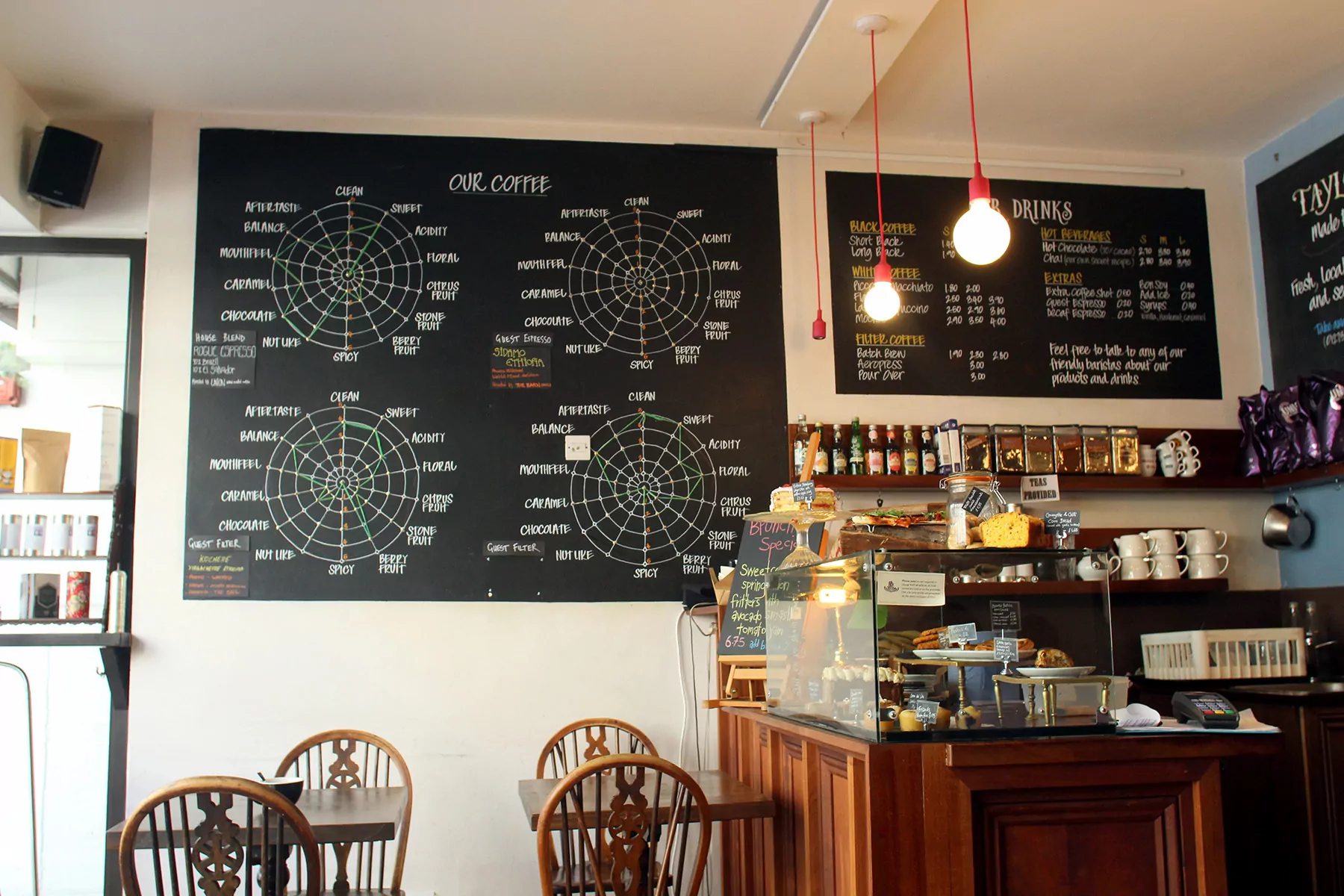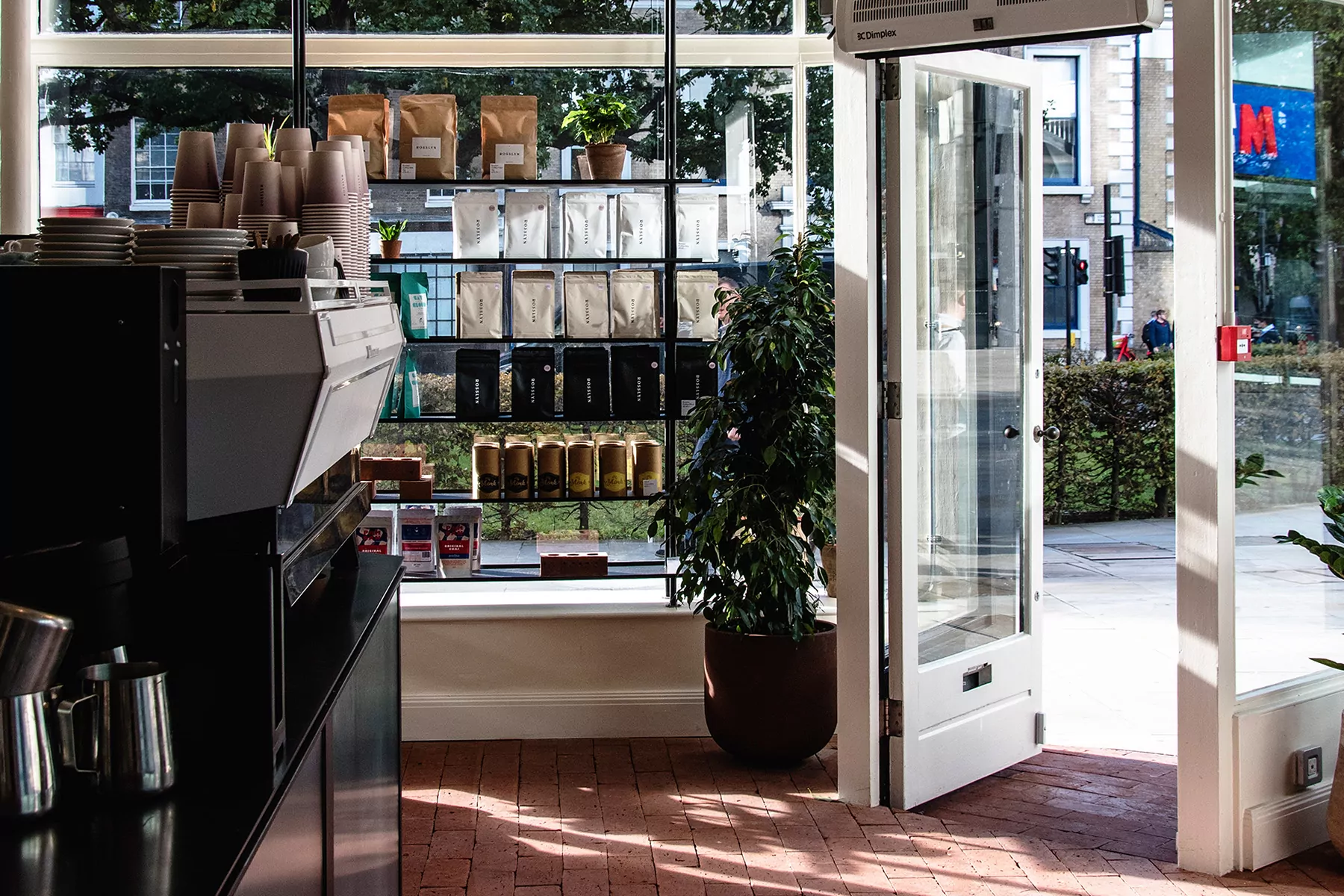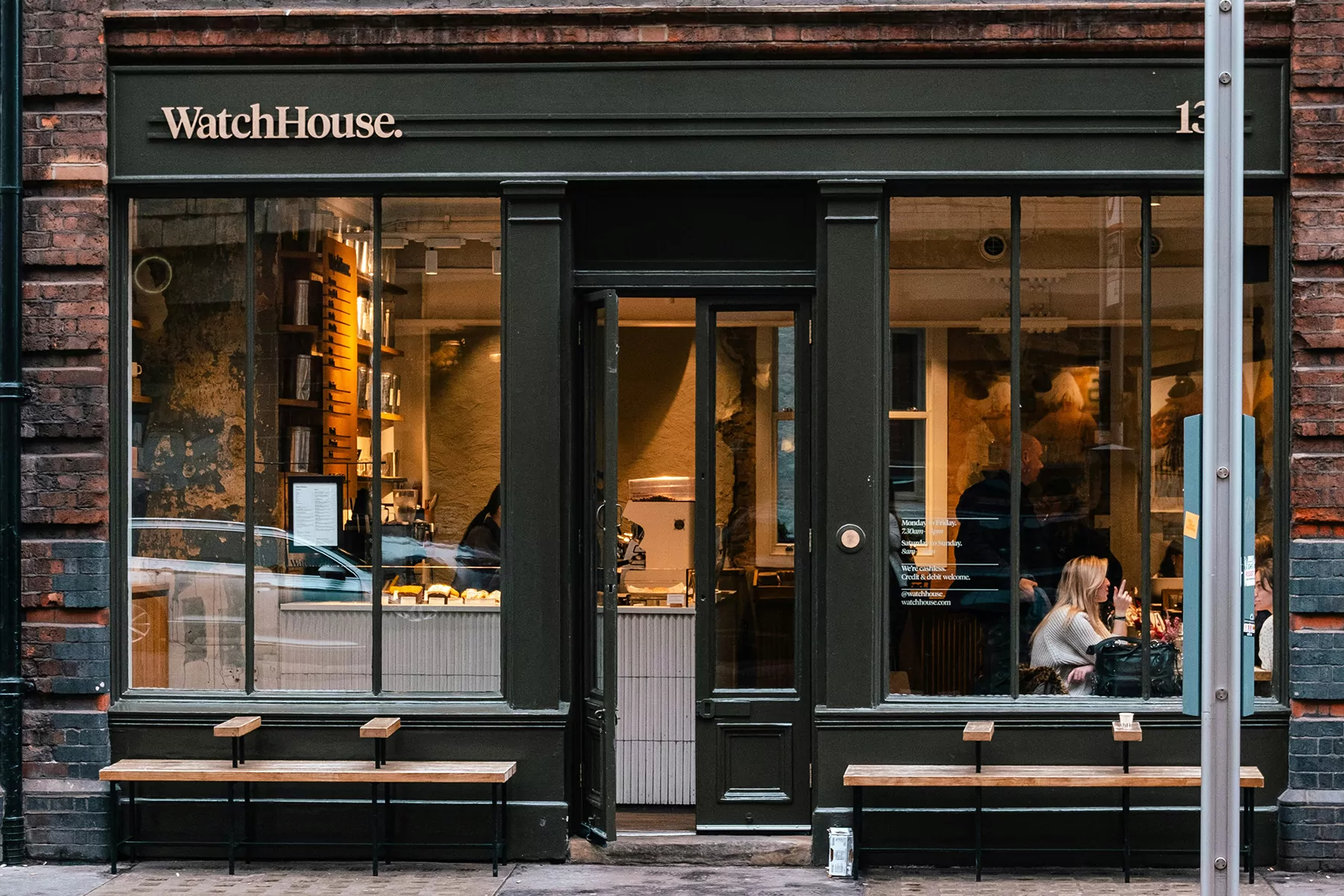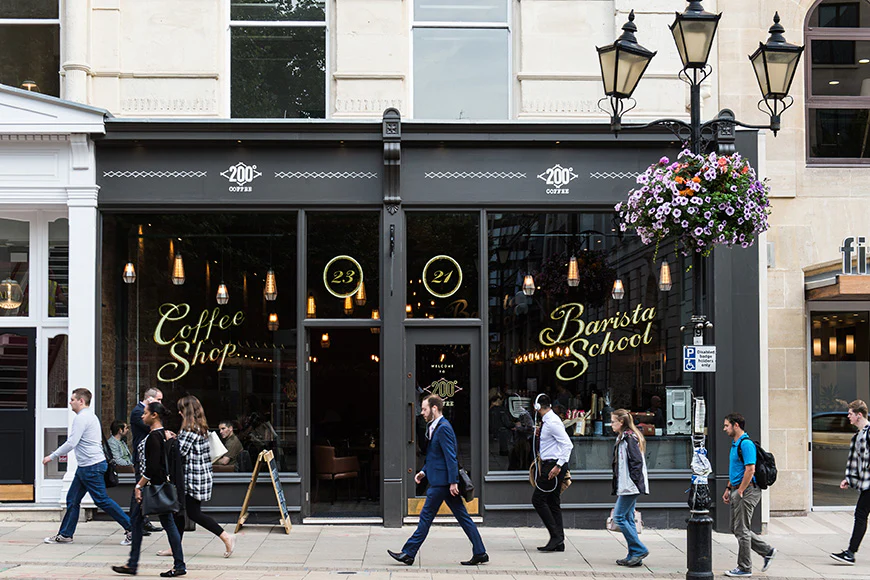
The profitability chasm starts when headquarters’ costs become greater than the profit generated by the shops. Many operators experience the edge of the chasm at three or four sites.
Get the latest Audio Articles by subscribing wherever you get podcasts
As a unique coffee business grows, it becomes increasingly average. This is a devastating realisation for many founders. A successful coffee shop can just meet the aspirations of a single group of consumers. The Gentlemen Baristas started serving coffee from a cart in Southwark before opening a charming shop in Borough. But coffee shops quickly outgrow their niche. To be viable at scale, coffee businesses must develop a proposition that simultaneously meets the aspirations of multiple consumer groups.
In the first article of this short series, we explored the implications of expanding from one site to two. The purpose was to offer some practical advice for proprietors thinking about opening a second shop as well as to build a foundation for this article. If you haven’t read it already, circle back now. It’ll help you to better appreciate the focus of this article: understanding the challenges that arise when expanding from two shops to three, four or many more.
As we’ll discover, it’s at this point that things become both complex and interesting for the coffee entrepreneur. Scale creates multiple challenges, but our analysis focuses on one critical concept: the profitability chasm.

It is noteworthy that there are many successful two-site coffee shop businesses, however there are few profitable five-site companies. This is a function of the profitability chasm. Just when the business’s operations increase in complexity, revenue and costs become uncorrelated. What once was a profitable business, now trades at a loss.
We start this article by exploring the market forces that contrive this situation. First we explore why single site propositions do not scale well. Then we overlay how operational costs change as the business expands. Together, these aspects identify the extent of the profitability chasm and explain why it’s difficult to cross. This approach allows us to understand why so many multi-site specialty coffee businesses have failed.
The outcome is the industry landscape we are familiar with. In a region that can, say, support a dozen specialty coffee shops, there are more likely to be 12 independent businesses than one company with 12 outlets. Of course, in reality, there’s likely be a mixture of one-, two-, three- and, even, four-site coffee companies operating in this area. However, it is important to recognise that the multi-site operators have little comparative advantage over their single-site competitors, if any. Their larger size doesn’t enable them to deliver better products, cheaper prices or enhanced service. And, ironically, for reasons the analysis will make clear, the four site operator is less likely to be profitable than their two site competitors.
This is just one of the reasons why we assert that for the foreseeable future, specialty coffee is likely to be a network of thousands of small, independent coffee shops. And an underlying theme of this series is that this is a beneficial industry structure. United Baristas thinks the industry should stop idolising specialty coffee chains and start celebrating who we already are. Small coffee businesses are the heart of specialty coffee, the foundation of its success and likely to shape its future.
Single site concepts don’t scale
There are multiple successful specialty coffee propositions possible, but for this example let’s consider a shop that focuses on 87+ point coffee. Having identified a site with agreeable rent in a central urban location, the business benefits from a core clientele of local regulars. But enhancing the business’s financial performance is the bonus revenue generated from occasional customers who travel from across the city to sample this shop’s exclusive brews. These customers visit infrequently, but there is enough of them to add, say, 10 – 15 percent to average daily takings.
To make this example fair, let’s say the business is well run and has a good profit margin. A five, 10 or 20 site roll out will look attractive on paper, but is likely to fail in practice. To begin with, it is unlikely this number of suitable premises could be identified, even in a large city such as London. But even should the entrepreneur succeed to procure enough suitable shops, these sites are now likely to under-perform the original. In this hypothetical example, five sites might only have the turnover of four times the original store as customers now have a reduced need to travel. If this distinctive business was to scale, it is likely to suffer increasingly average performance.
The coffee community has witnessed this trend time-and-again and this vantage point is useful to foresee various challenges. Think about a shop that serves flat whites to office workers in a financial district. Scaling the business hinges on finding multiple locations that have the same customer requirement but are not so nearby as to cannibalise trade. Customers have different priorities based on their location, such as their available dwell-time, a desire to be seated, a requirement to use the loo and the attractiveness of child- and dog-friendly facilities. If the owner opens in an adjacent shopping district or a neighbourhood popular with creative industries, the business is unlikely to work well without modification.

The challenges facing entrepreneurs escalate in mature competitive markets. Coffee drinkers are a diverse collection of people, with an abundance of aspirations and preferences. So the greater the choice of shops available, the more likely it is that coffee drinkers will choose a premises that most exactly meets their priorities. This is exampled in our local coffee shops. Within a 15 minute walk, it’s possible to visit over a dozen good, specialty coffee shops that include a design-led store, an art gallery, an espresso bar, a bakery, a vegan café, and a family-friendly kiosk in the park. Every local has their favourite and distinct tribes congregate at each shop.
In search of margin
If you view specialty coffee company pitch documents, they often assume increasing margins via cost reduction, rather than price increases. In practice, most find that net profit margins don’t significantly widen as they scale. To consider the implications of the profitability chasm, we need to understand why.
At shop level the most significant costs are staff, ingredients, rent, utilities and business rates. Together these account for around three-quarters of outgoings. This greatly limits options for cost cutting. For example, it isn’t a good business plan to pay people less as you grow. Wages are established by the labour market with a baseline set by legislation. In fact, entrepreneurs would be prudent to budget pay increases to help mitigate any impacts of scaling on the company’s culture and to support staff retention.
Rent, too, is set by the market and is likely to increase over time. Favourable rent on early leases will vanish as landlords will expect full market rent once the business is established. Your landlords will, rightly but predictably, detest the idea that their favourable terms are funding your growth and allow the business to pay other landlords the full going rate.

Other key costs, such as business rates and water are fixed. There are some limited cost savings possible at scale, especially across energy, packaging and waste removal. However, once these avenues have been exhausted, management is left with little option but to cut ingredient costs.
A recurring surprise amongst managers we spoke to for this series was the limited scope suppliers had to reduce wholesale prices. One way of looking at this is that food and drink wholesale is a competitive sector and many wholesalers offer competitive prices to win accounts.
Consequently, many expanding coffee businesses cut their cost of goods sold by switching suppliers. Cost savings are often possible for growing coffee businesses by switching to a mainstream foodservice company, which has the consequence of reducing the business’s distinctiveness. The trend towards an increasingly generic proposition is a theme we’ll return to in the next article of this series, but for now it’s worth noting that selling a less differentiated proposition requires greater marketing firepower.
Winning customers becomes more expensive
Counterintuitively for many founders, customer acquisition costs increase as the business grows. Few small coffee businesses allocate any budget for advertising or promotion. Initial customers are cheap to acquire, if not free. By prioritising customer service, the business can rely on word-of-mouth, blended with social media, to build a profitable customer base.
The next cohort of customers have a less well-identified need for your products or services. Attracting these customers requires marketing effort, whether it be education, promotion or advertising. And additional customers quite possibly haven’t heard of your company or its products and require a full suite of marketing activity to be won over. In short, to grow, most businesses spend more money to reach more marginal customers.
Headquarters’ costs increase
A medium-sized coffee business can expect to have people working on human resources, finance, stock management, logistics and training. There are also functions to be managed that are often outsourced such as cleaning, equipment maintenance and bookkeeping.
At one or two sites, almost all employees are customer-facing. If they do their job well, they’ll boost revenue. At this stage, companies add headcount to serve more customers and increase takings. Around three or four sites it makes increasing operational sense to consolidate functions into newly-created roles at headquarters.
The creation of operational, non-revenue-generating roles at headquarters creates a financial burden on the business. Now the shops need to be sufficiently profitable to cover both their own expenses and contribute towards headquarters’ costs.

The profitability chasm
The profitability chasm starts when headquarters’ costs become greater than the profit generated by the shops. Many of the operators we’ve spoken to experienced the edge of the chasm at three or four sites.
The crux is, while business operations become smoother with the addition of people at headquarters, the increased ease doesn’t translate into sufficient additional revenue for the business to be profitable. In fact, at this stage of a specialty chain’s growth, the operational requirements and revenues are completely out of sync.
Faced with disorderly operations or financial losses, entrepreneurs seek to open additional sites to cross the profitability chasm and attain a level of sales revenue that can support headquarters’ costs. This decision triggers a treadwheel where new sites are added, additional operational requirements arise which necessitates further headquarters investment.
This is often a chaotic moment. Adding operational capacity helps tame disorganisation but adds cost and shortens the duration the business can sustain losses. Consequently, operational capacity is often added only when it becomes absolutely necessary. Many entrepreneurs openly shared their memories of the stress created from walking this tightrope between profitability and operations.
As awareness of the profitability chasm has grown, subsequent cohorts of entrepreneurs have sought to bridge it by planning and fundraising for a multi-site rollout in advance. This raises a strategic question, how many profitable shops are required to support the associated operational infrastructure?
All the founders we spoke to for this article were profitable at two sites, entered the profitability chasm around three or four sites, and generally struggled to achieve profitability again. Some found financial reprieve at specific moments, such as during exceptional periods of trading or achieved short-term profitability by temporarily underinvesting in operations. Others, bolted auxiliary functions on to the business such as roastery wholesale and e-commerce. But time and again, these moments proved to be unsustainable and the businesses eventually become constrained by cash flow and crippled with debt.
Estimations vary for the number of shops required to achieve profitability. Some entrepreneurs estimate seven, others calculate it to be around a dozen, and others think it’s as high as 20 stores. Our estimate is, entrepreneurs are in fact running off a cliff, not bridging a chasm. We think the number of required shops is likely to be so large as to necessitate the business becoming fully mainstream. At this point, it would no longer be a strategy for creating specialty coffee chain; rather it’d be a playbook for launching a new high street coffee business. And none of the founders wanted to do that.
Our rationale is based on the observation that, rather than achieving economies of scale, these businesses suffer from exponential decay. Additional shops contribute diminishing returns or, worse, just saddle the business with greater debt. This position isn’t just theoretical. All the founders that proffered a profitable size selected a number of stores greater than the number of stores they actually opened. And after more than a decade of attempts, the profitability chasm is yet to be crossed.
Furthermore, none of the current businesses scaling specialty coffee shops have grown to a size where store profits cover headquarters’ costs. Some of these businesses now have more than 20 sites. From the perspective of this analysis they are like Wile E. Coyote once he’s run over the cliff’s edge. For a time he defies gravity, but we all know what happens when he looks down.
Increasingly vulnerable to upstarts
It’s at this point that multiple factors combine to make the business vulnerable. Financial pressure increases from growing headquarters’ costs, there’s a necessity to expand the proposition to reach new customers, and the business must support greater marketing costs. In this set of circumstances, management often cuts the cost of goods sold, often by switching suppliers. The business is now becoming less distinctive – and increasingly vulnerable.
As the business becomes more generic, customers are incentivised to switch to establishments that have a more attractive proposition. The competitive nature of the industry has been a feature since its inception. It’s brutal. It can make running a successful coffee business of any size challenging. But it’s also a source of constant renewal and a driver of the industry’s dynamism. It’s a central reason why specialty coffee has stayed at the forefront of consumer preferences and aspirations. And we see no sign of it slowing down.
Don’t bemoan the situation. While it’s challenging for chains, it’s good for the industry. Over the last 15 years, specialty coffee shops have evolved rapidly. At times, the industry has shaped consumer preferences and been responsive to their aspirations in others. Time and again, independent coffee shops have demonstrated that they can out-pitch a coffee chain. They are more committed to their customers, have greater agility and can build a location-specific proposition. Plus it’s easier for owner-operators to maintain a strong hospitality focus. These are the businesses and stories United Baristas thinks the coffee community should be celebrating.
How to build a specialty coffee chain
So, is all lost for entrepreneurs wanting to build a specialty coffee chain? At present it’s very difficult, if not almost impossible. It’s challenging to see how a coffee business with The Gentlemen Baristas’ proposition could have succeeded when others had already failed. But the environment is changing with the introduction of new technologies, alternations to the regulatory environment and new trends re-shaping menus.
In the third and final article of this mini-series we explore the conditions necessary for a successful specialty coffee chain. Plus, we share tips from founders that have sought to scale specialty. Before we get started, now’s a good moment to revive yourself with a cup of coffee. Or, if you are a specialty chain investor, maybe you wish to reach for something a little stronger.

 Give Coffee If you found this article useful, show your appreciation
Give Coffee If you found this article useful, show your appreciation